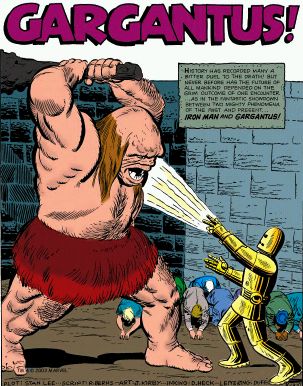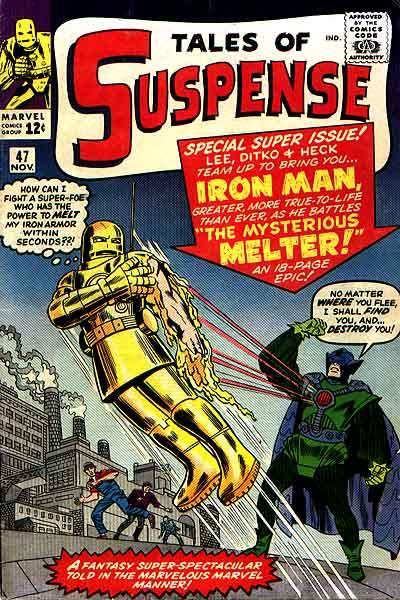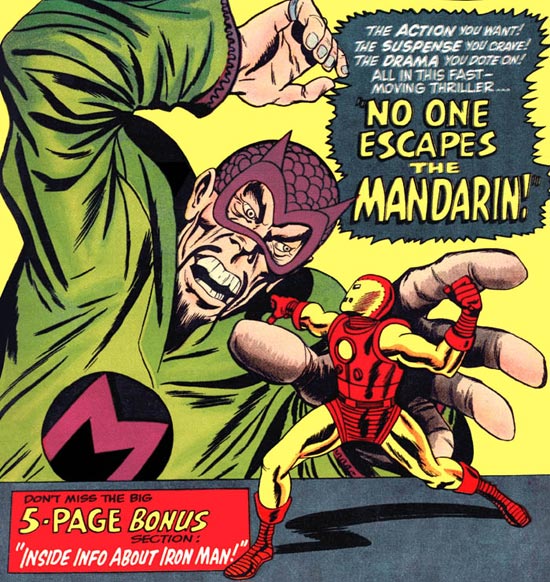The best of superheroes have the best villains. If you want to take down the golden avenger, you have to be a cut above average as villains go. So what will it take?
Start with actually having something against Iron Man. You’ve got to have a reason to want to face him in particular. If you’ve just been standing there for thousands of years and happen to run into Iron Man, that’s not going to work.
Take Gargantus from Tales of Suspense #40. Using information that was 80,000 years out of date, some aliens made the giant robot to enslave the human race and then put the robot in North America where no Neanderthal ever lived.
If you just happen to be standing there waiting to hit someone when Iron Man happens by, you’re going nowhere and neither did Gargantus. He and the stupidest interstellar aliens in the galaxy were never seen or heard from again.
So, you have to hate Iron Man. You also have to have some staying power. Look at Queen Kayla of the Netherworld from Tales of Suspense #43. The Netherworld was one of those underground civilizations that peppered early Silver Age comics, popping up in Fantastic Four (Mole Man), the Hulk (Tyrannus), and Iron Man.
In this case, a city in the country Atlantis (which in Plato’s myth was a citystate, no multiple cities) survived the earthquake and sank underground. When they attacked, Iron Man battled them. He took Queen Kayla to the surface. There she aged rapidly. Iron Man had to take her back to reverse the process or she would have died of old age within minutes. Naturally, that made whatever plan B was a much better idea than the plan A of the army attacking the surface world. Gone was any chance of wars with Atlantis, the Mole Man, or Tyrannus. Gone were crossovers, battles with other superheroes, and return engagements with Iron Man. Kayla had no staying power. If you don’t have a comeback, go away.
In the same way, don’t be too specialized. The Melter from Tales of Suspense #47. Need I say more?
OK. Basically, he melts metal (originally just iron) and damages Iron Man’s armor. Iron Man overcomes the melting (the first time he made armor out of aluminium) and with one hit, the Melter is finished. That is every story with the Melter in it. And, let’s face it, if Iron Man can’t be bothered he’ll call Daredevil because the Melter’s beam doesn’t affect wood. So the guy who thinks he can challenge Iron Man gets beaten up by a blind man with a stick. Even the editorial team decided the Melter suited simpler times and was uninspired. Pay attention to that.
If you hate Iron Man, represent something people hate. The original Firebrand hated Iron Man, but he represented a left-wing ideology at a moment in time when people in America generally were shifting to the left. There wasn’t enough to create fire between them (yes, that’s a pun). The Hulk smashes buildings and beats people up, but he doesn’t represent something bad, he doesn’t understand things and just wants to be left alone. So readers forgive him. Consider if the Hulk was head of the Sons of the Serpents and beat up interplanetary aliens and gays. Coming from the southwest, what if he hated Mexicans – including the ones who arrive legally?
Iron Man has always opposed dictatorships, tyranny, and corporate raiders. He began as a cold-war warrior, and that in itself tells us something you need to be if you are going to be one of his greatest opponents. Basically, tie yourself to something that lasts.
Many reasons are given for superheroes dropping out of favor after World War II. One of those reasons might have been that it simply was after World War II. The old reasons to fight bad guys weren’t so prominent. You couldn’t have the Red Skull without Hitler. Some heroes could adapt: Superman became a fantasy and spent a lot of time in other time periods and other planets. Batman became so science fiction- based he would eventually shout, “Not another alien with a strange ray weapon.” Captain America had no chance to adapt and did not successfully return until he became a man out of time.
In the same way, Iron Man was a cold war warrior. He even had to face Soviet champions on television to see whether capitalism or communism made the better armor. But the Soviets lost the cold war (don’t worry if you missed it, there was no celebration). So what do agents of the former Soviet Union like Titanium Man (Tales of Suspense #69), Crimson Dynamo (#46), and the Unicorn (#56) now represent? It’s the fall of Nazi Germany all over again.
They could be representatives of Russia, which kind of makes Vladimir Putin the bad guy. They could be representatives of an underground organization of communists, like Hydra is leftover Nazis. But Marvel has a lot of conspiratorial groups: Hydra, AIM, the Secret Empire, the Maggia, and Sons of the Serpents. Do they really need another one? And do we really need to see another case of the Nazi Red Skull turn into the Communist Red Skull after World War II?
Remember that Tony Stark was originally kidnapped by an Indochinese warlord. Not the Viet Cong, specifically, but at the very least in the same neck of the woods. More recently it’s been in Iraq or Afghanistan. Without the forces that back them, villains lose relevance.
So the former Soviet agents are still floundering for a solid role to play. Not so the industrial enemies like Obadiah Stane (Iron Man #163), Justin Hammer (Iron Man #120), and maybe even Modok (Tales of Suspense #93). People go after Tony Stark and Stark Industries on the basis that getting him will cripple Iron Man. And several times that kind of attack has been a good story arc. It is one path to being a significant Iron Man villain.
Another path is the “evil version of me,” the Red Skull to Captain America, the Joker to Batman, General Zod to Superman, and so on. So the Beetle (should he ever de-reform) and the ex-Soviet armored guys might fit in here. So might Whiplash because he certainly fit in that way in the second Iron Man movie. It is the Iron Monger armor (Iron Man #200) that makes Stane a better villain than Hammer. It makes Stane a closer opposite to Tony Stark/Iron Man and got him first off the bench to be an Iron Man villain in the movies.
If you can go one-on-one with Iron Man in your armor (components may be stolen, but the armor as a whole can’t be or it looks like a bad story) you can be a top enemy. But it works best if you’re working for someone else because that armor needs backup. This is why the Cobalt Man (X-Men #31) skirted the edges for a while and then died. But there is real danger in becoming too close a parallel to Iron Man. Crimson Dynamo, Titanium Man, the Unicorn, and Iron Monger all died. So many, so similar, so dead: police tend to get suspicious when that happens. They don’t believe in coincidences, and neither should we. Being too similar, these villains tend to provide an intense rivalry but not to last long.
Other villains without a distinct motive or a parallel tend to be also-rans. So enemies like Blizzard (Tales of Suspense #45), Fin Fang Foom (Strange Tales #89), the Living Laser (Avengers #34) and Spymaster (Iron Man #33) are doomed and will just not make it.
If you want to be a really good enemy of Iron Man, you have to threaten him, his company, and his way of life in the name of evil. You need to represent a force that challenges America the way the Soviet Union used to. You need to represent something on the rise, just as the Soviet Union was a “rising” power. Then challengers like the Titanium Man were there not only to defeat Iron Man, but to show that communism was better than capitalism. It was to show that, eventually, the Soviet Union would take charge and Stark Industries would be nationalized. You need someone with that kind of caveat.
Basically we’re looking at the Mandarin. He is superb at martial arts and can crack open Iron Man’s armor with his bare hands. He has ten rings with which to match Iron Man’s repulsor rays, chest beam, and similar weapons. So he’s a good match in any one-on-one fight. He rules an undefined area of China, so he represents an authoritarian economic system. It does not have to be communism, per se, but it is unlikely to be classic capitalism. It might be state-sponsored capitalism, where large companies receive both directions and support from the central state (this is what China has now).
However, more broadly, the Mandarin represents the rising power of China. When the Mandarin was created, China was a place of poverty and death. No wonder the Mandarin looked back to a previous, imperial China. They seemed to be yesterday’s nation, the Soviet Union was tomorrow. Funny how things work out.
Now China is a burgeoning economic power, a member of BRICS: Brazil, Russia, India, China, and South Africa. BRICS is expected to produce 45% of the world’s GDP by 2020. It is setting itself to challenge the International Monetary Fund. China has more industrial production than the United States and the margin is growing. China is America’s largest foreign creditor. Their space program is third and Russia’s is running on empty so it may soon be declared second.
The Mandarin can represent all of that and more. He is a threat to Iron Man as an individual and the political and social system of the United States. If the Mandarin has bought into Chinese corporations, he could be a closer opponent to Tony Stark, threatening Stark Industries. The Mandarin can also provide products without concern to the health of his employees: made in China by slave labor. Issues of stuff made this way could move from headlines to comic-book arcs. If that seems too real, don’t forget, comic books declared war on Hitler long before FDR got smart enough to do that, despite the hate mail guys like Captain America generated. Comics also got involved in matters of civil rights and (rather late in this case) feminism. There is no issue too real for comic books to tackle.
Tony Stark would certainly find allies because the Chinese government hates the Mandarin. On this scenario, he would have followers in chosen positions. In other words, the Mandarin would be running a kind of a Chinese HYDRA. It makes it easy to do traitor-in-the-camp stories.
Iron Man has always been where the world hung in the balance. An enemy who can threaten that world on a physical, financial, and cultural level is somebody in Iron Man’s league who might win. If people hate them and know they’re going to be around for a long time as well, then you have a classic Iron Man villain.





Comments are closed.